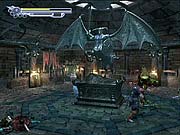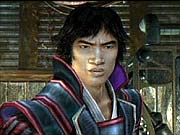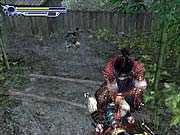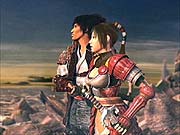A game about a demon-slaying samurai indisputably deserves an encore. Considering the soundness of the concept behind the hit 2001 PlayStation 2 action adventure Onimusha: Warlords, it should come as little surprise that the sequel is a very similar game. Like its predecessor, Onimusha 2: Samurai's Destiny is a cinematic action adventure game with plenty of great-looking hack-and-slash combat and a little puzzle solving thrown in to make it last longer. As the vengeful samurai Jubei Yagyu, you'll travel from one beautifully rendered static scene to the next, fighting hundreds of demonic adversaries in your quest to find and defeat the resurrected warlord Nobunaga. Fans of the previous Onimusha game will likewise enjoy the sequel. However, they'll find that Onimusha 2 also has the same drawbacks as its predecessor, including some frustrating camera angles and a relative short main quest. Some bad English voice acting also hurts the game's otherwise excellent atmosphere. Those new to the series are just as likely to notice these problems, but they'll certainly also appreciate the stunning production values of Onimusha 2.

The story of Onimusha 2 is like a retelling of the first game. Much like how Dracula always comes back to life from one Castlevania game to the next, in Onimusha 2, the first game's main bad guy, the evil Nobunaga, has once again risen from the grave and is seeking to take control of Japan using his monstrous armies. In the game's impressive opening cinematic, the first of a number of outstandingly produced prerendered cutscenes featured in the game, you'll watch Nobunaga's forces lay waste to Jubei's village. An expert swordsman, Jubei is the sole survivor of the onslaught. While some of the story is told using prerendered cinematics, most of it is told using real-time cutscenes that feature the game's highly lifelike and meticulously detailed 3D character models. Motion-captured animation lends both the noninteractive cutscenes and the action itself some real dramatic flair, and there's a good balance of action and story--you'll view the occasional story sequences as rewards for getting past the action sequences.
Though you'll primarily control Jubei throughout the game, he'll also meet four other warriors during the course of his adventure, and they'll occasionally fight alongside him. You can occasionally interact with these other characters, but that interaction is mostly limited to offering them whatever trinkets you've come across with the hope of getting something from them in exchange. Sometimes you'll even get to control these other characters directly, though while they look different from Jubei and use different fighting styles, they essentially play the same.
Like its predecessor, Onimusha 2 is comparable to Capcom's famous Resident Evil series because of its mechanics and overall structure. The controls here are just like in Onimusha or in a typical Resident Evil game. Forget the analog sticks on your gamepad--you rotate your character by pushing left or right on the digital pad and make him run forward or retreat by pushing up or down, respectively. Though they control just like Resident Evil, the pacing of the Onimusha games is actually very fast, which is why it's surprising that Capcom has stubbornly refused to provide an analog control scheme. Those unaccustomed to Resident Evil-style controls will undoubtedly see Onimusha's controls as cumbersome and behind the times, though to be fair, the controls are actually pretty good once you get used to them.

Though combat in Onimusha 2 often requires little more than mashing on the square button to slash repeatedly, the game actually rewards finesse, since a carefully timed strike can be used to critically injure multiple enemies. Jubei can also block enemy attacks, imbue his weapons with elemental magic, and, much like the previous game's main character, absorb the souls of slain enemies. Absorbing souls restores Jubei's health and magic power, and it also lets you upgrade your equipment to more powerful forms. Jubei will get to wield a number of great-looking weapons throughout the game, though they are effectively interchangeable for the most part, so you'll switch between them based on personal preference instead of tactical necessity.
The sequel has a gentler learning curve than the original and is actually quite easy at first, though you'll soon reach some encounters with powerful boss monsters that are quite challenging. Die a few times, and the game will all but insist that you continue on in the easy difficulty mode, which makes it so pretty much any player could finish the game without breaking a sweat. That is, provided the player doesn't get stumped by any of Onimusha 2's puzzles, which are pretty simple but might confuse you for a while. Actually, most of the puzzles are purely optional and are used to lock away power-ups that you can opt to leave behind.
What aren't optional are all the locked doors you'll come across in your journey, which will sometimes require you to backtrack in search of the necessary key, or wander about the area fighting the same types of respawning monsters, trying to figure out what you're supposed to do next. The solution in such occasions tends to be obvious, and you'll kick yourself for not figuring it out sooner. But it's not your fault--the prerendered 3D backgrounds, as impressively detailed as they are, can still be somewhat grainy, making it difficult to see certain passageways. Fortunately, you have access to a map in most cases, and even if you get stuck, the action is fast and fun enough to keep you from getting bored.

The generally impressive appearance and memorable character designs of Onimusha 2 are part of the reason some other aspects of the game seem very awkward. The translation of the written dialogue leaves something to be desired, but it isn't nearly as bad as the spoken dialogue heard in all the game's cutscenes. You'll eventually get used to Jubei, but some of the other characters--like the mysterious women who grants him his soul-sucking powers early on in the game--sound downright terrible. Moments in the story that are supposed to be touching or emotional in any way always end up falling flat because of the mediocre voice-over, which is a shame.
What's even more disappointing is that no Japanese language option is available, unlike in Onimusha and Genma Onimusha for the Xbox. The Japanese style and setting of Onimusha 2 is exactly what's most endearing about the game. Conversely, people who are uninterested in a Japanese-themed game aren't going to pay Onimusha 2 a moment's notice, regardless of what language its characters are speaking. So, knowing that every last person who plays Onimusha 2 is going to have some interest in the game's setting, why would Capcom leave out the option to let you hear the characters in their native language? The answer actually doesn't matter, because the fact remains that Onimusha 2's shoddy voiceover detract from the overall quality of the game. For what it's worth, the game's subtle musical score and various sound effects are all top-notch. The sounds of battle, from clanging steel to splashing blood, really help intensify the action.
Onimusha 2 has a very distinctive look about it, combining photo-realistic textures and environments with some decidedly otherworldly scenery. The human characters often look almost real. Jubei himself bears the likeness of the late Japanese actor Yusaku Matsuda, and the game's other protagonists look like real people, too. Ambient animations and some clever effects in the otherwise static scenery help make it seem more tangible, though you can still usually tell that your character and his enemies are the only truly 3D elements onscreen. Nevertheless, Onimusha 2 is a gorgeous game, and it looks even better in motion than it does in pictures. Some of the camera angles are frustratingly detrimental to the gameplay, causing you to get blindsided by opponents who you really ought to be able to see, but there's no denying that this is one fabulous-looking game.

Experienced Onimusha players should be able to get through the sequel in less than 10 hours, though those who are either unaccustomed to action adventure games of this ilk or unwilling to switch to the easy difficulty setting may find the game to be considerably longer. Finishing Onimusha 2 unlocks a number of amusing special features, in addition to the ones available from the start, which include a "making of" movie and more. The presence of these unlockable minigames and the optional subquests and situations offered by the main story mode lend Onimusha 2 good bit of replay value. What's most important is that the fast-paced action is inherently enjoyable, which makes the prospect of going through the game more than once seem like a reasonable idea.
It's plainly obvious that a lot of effort went into Onimusha 2, at least on the production side. This is a graphically stunning game with a distinctive style, some great character designs, and plenty of pretty scenery. It's also a fun action game to boot, and a faithful though somewhat uninspired sequel. Onimusha 2 could have been longer, and it could have offered an analog control scheme. It also should have offered a Japanese language option like its predecessors. These aren't major concerns, though. After all, it's easy to find fault with games that have a lot of strengths. The ending of Onimusha 2 segues into a trailer for the next installment in the series, which is being billed as the final episode. The bottom line is, many of those who reach the ending will find themselves anticipating that next chapter starting right then and there.